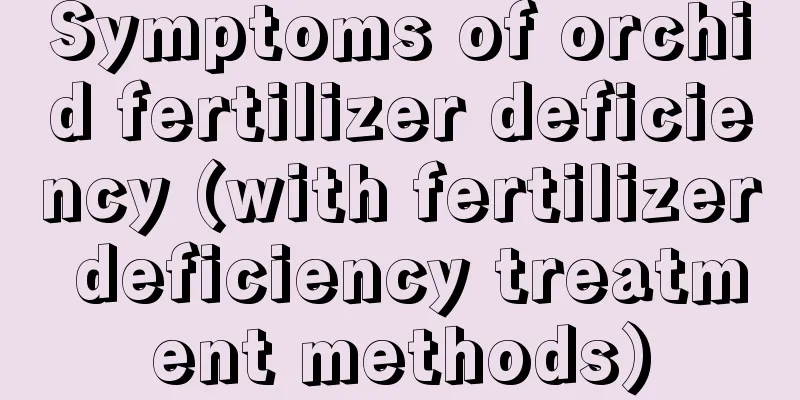Symptoms of orchid fertilizer deficiency (with fertilizer deficiency treatment methods)

1. Symptoms of Fertilizer Deficiency1. Nitrogen deficiency: Nitrogen can promote the growth of orchid leaves. When nitrogen is deficient, the plant will have problems such as new leaves growing poorly, being thinner than old leaves, and having dull color and luster. 2. Phosphorus deficiency: Phosphorus fertilizer can promote the germination and growth of orchid leaf buds. When the leaf buds of the plant grow slowly and the leaf edges curl, it means that the plant may be lacking in phosphorus. 3. Magnesium deficiency: Magnesium is an important element for the synthesis of chlorophyll. When orchids lack magnesium, their chlorophyll will decrease and the leaves will turn yellow. 4. Potassium deficiency: leaf edges and tips turn yellow. First, the old leaves turn yellow, and gradually the new leaves also begin to turn yellow, and then from yellow to brown. In addition, the leaves of the plant will become softer and easier to droop. If exposed to strong light or low temperatures, the leaves will become dehydrated. 5. Calcium deficiency: The leaves will change shape, affecting the appearance of the plant. II. Solutions1. Nitrogen deficiency: Irrigate the roots with potassium sulfate compound fertilizer solution, and the plant will slowly recover. Or you can spray urea solution on the leaves in the evening, once every three to five days. Repeat three times and the new leaves will return to normal. 2. Phosphorus deficiency: You can use potassium phosphate solution to irrigate the roots once every ten days, and the condition will improve after two times. Or you can spray it directly on the leaves. Spraying foliar fertilizer will be effective faster. Apply it once every three days, and the condition will improve after three times. 3. Magnesium deficiency: In the evening, spray 0.5% magnesium sulfate solution on the orchid leaves. Spray once every three to five days, and spray three to five times in a row to solve the problem. 4. Potassium deficiency: Use 0.5% potassium sulfate solution to water the roots and spray the leaves, and you can also sprinkle some wood ash. 5. Calcium deficiency: You can solve the problem of calcium deficiency in orchids by irrigating the roots with 1% lime solution once. |
<<: Is compound fertilizer effective for orchids? How to apply compound fertilizer
>>: Can orchids use bean cake fertilizer? How to apply cake fertilizer to orchids
Recommend
Can potassium dihydrogen phosphate make leaves green (can spraying potassium dihydrogen phosphate cure yellow leaves)
Can potassium dihydrogen phosphate cure yellow le...
The difference between Aspidistra and Spathiphyllum
1. Morphological differences The rhizome of Aspid...
Bougainvillea grafting method
Grafting preparation Preparing tools Home graftin...
Can evening primrose be used to make tea?
Can evening primrose be used to make tea? Evening...
The fastest way to root peony cuttings
Peony cutting time In order to ensure the surviva...
Method of hydroponic cactus
Select the parent First, choose a cactus with a s...
How to propagate the colorful ironwood? Cutting and layering propagation methods
Reproduction method of colorful iron The common p...
Time and method of cutting of five-color plum
Cutting time of five-color plum The five-color pl...
When does peach blossom bloom?
1. Flowering period The flowering period of peach...
How to water osmanthus
Key points for watering osmanthus Osmanthus prefe...
Peach tree management measures in January
January is already a cold winter and most peach t...
How to care for Begonia in winter
Is Begonia afraid of freezing? The most suitable ...
When and how to plant winged beans
Planting time of winged beans Winged beans are no...
Is the fortune tree still alive if its bark rots?
1. Can I still live? The bark rot of the money tr...
How to propagate Lilium
Seed propagation of Lilium lily Seed propagation ...









